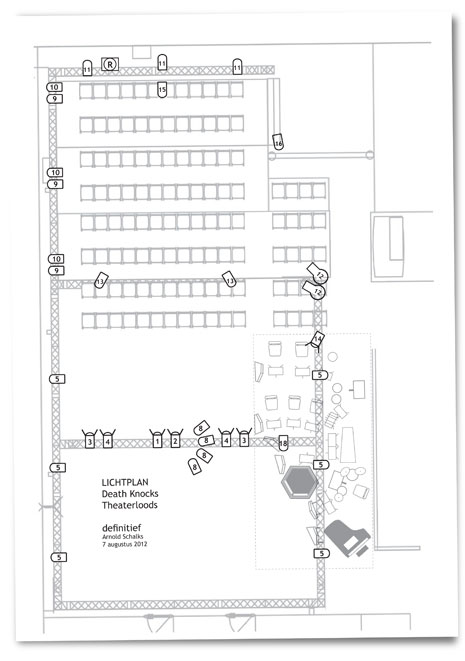David Prins / Mittowch, 2. Mai,
2012
text
Woody Allen's play is situated in the (Jewish circles) of New
York. He wrote it in the 1960's for locals of that time. Some aspects of his
text get lost for a contemporary Dutch audience, because it evokes no, or
other associations. For example:
'Our' audience cannot understand the Yiddish
elements in the English text.
References to typical American brands or (Fresca, Bickford’s)
don't evoke an ‘image’ or an ‘atmosphere’ .
The game Gin Rummy is not well known to us, we rather play poker
or Rummikub.
music
Jost's music interprets Allen's text. The fact that Jost's characters
sing, is - especially for a text by Woody Allen - a serious intervention.
Allen often seems to let his characters chat endlessly, but under that nervous
flood of words an undercurrent of lonelyness and impotence becomes tangible.
Because the music slows down the text and the words are being pronounced more
ém-phá-tíc, they loose that typical 'Allen-brilliance'.
But even more drastic is, that the fúnction of all these words:
to conceal or defuse an existential panic, is neutralized. It is crucial to
analyse the consequences of Jost's interventions/additions to find the right
guidelines for our visualization.
theme
The theme is death struggle. The form of representation is comedy.
Man fights Death to gain a longer life. An allegory. Death against a mortal.
Two worlds - the 'here and now' and the realm of Death - collide when Death
stumbles into the world of the living. The mortal doesn't want to surrender
just like that and tries to control his own destiny. He challenges Death;
he seduces and deceives him.
the performance
We neither try to restore the 'Allen-timbre' that got lost in the music, nor
do we attempt to reconstruct the New York atmosphere of the mid-1960's; we
now live in another place, another time. Jost removed the Jewish-American
accent from the text. We will not 'reconstruct' a Jewish element by means
of visual additions, because it is not essential for Jost's version. We will
transform the theatricality of the musical structures in (stage) design. We
will make use of the features of comedy, in acting style as well
as in staging. The performance can be considered as a theatrical narration.
Both protagonists and audience are fully alive that we deal with an acted
out story. The man and Death - hís personal Death - are complementary:
Death as the man's reflection, maybe even the man's projection. If the man
succeeds to get suspension from Death, he might be able to really be alive
(maybe even for the first time?). The man chooses his favorite music (Artie
Shaw's 'Concerto for clarinet')
to celebrate his victory. When the music is over, he will die - no human being
beats Death in the end.

Death Knocks im Theater
de Veluvine, Nunspeet.
the space
The auditorium is the stage, the grandstand the set. There we see a man, a
dress manufacturer, seated in a sea of empty chairs. Where are the others?
Were they already taken or aren't they born yet. Shouldn't wé - the
audience - sit over there? The audience is seated on the actual stage, looking
up to the nearly empty grandstand. Death enters the space of the living and
has problems to make his way to his 'prey'. The rows of seats are obstacles
that make it hard for Death to approach the man directly.
the characters
It's evident that both roles – man and Death – are stage characters:
the man is an old clown, Death his alter ego. Death will eventually
take the man to the Beyond, but not before the man has celebrated his extra
time with a little dance with Death, a danse macabre maybe, but one
which Death danced to hís tune. The clown suit of the man has long
coat tails: two long strips of fabric, each rolled up on carton rolls, which
he keeps pressed under his arms. He will finally be no longer able to hold
them: they unroll and Death will tenderly 'mummifie' the man in the tails
of his coat. Death – sung by a soprano – will be performed as
a male character (Hosenrolle). The Death-character can be considered
as the man's projection. Likewise, the Clarinettist can be considered as the
man's projection: Death as the Death he's dreaming of, the Clarinettist as
the Life he's dreaming of. All figures are dressed in an excessive and exuberant
manner.
the props
The props will clearly be 'stage requirements'. They may differ from the realistic
objects they represent in material, colour or design. The card game for instance
will not be played in a realistic way, but will express and symbolize the
struggle for life and death. In that respect the cards represent the weapons
for that trial of strength.
the light
The light will turn the auditorium (the grandstand) into a theatrical space.
The profit of the extra day which the man purloined from Death will be visualized
in the course of the clarinet concert and will be accompanied with appropriate
lighting.

Lichtentwurf für
de Theaterloods, Radio Kootwijk.

